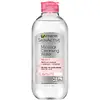What's inside
What's inside
 Key Ingredients
Key Ingredients

No key ingredients
 Benefits
Benefits

 Concerns
Concerns

No concerns
 Ingredients Side-by-side
Ingredients Side-by-side

Water
Skin ConditioningButylene Glycol
HumectantDisodium Cocoamphodiacetate
CleansingPEG-6 Caprylic/Capric Glycerides
EmulsifyingUrea
BufferingPolysorbate 20
EmulsifyingSalicylic Acid
MaskingSodium Chloride
MaskingPEG-40 Hydrogenated Castor Oil
EmulsifyingAllantoin
Skin ConditioningSodium Glycolate
BufferingCentella Asiatica Extract
CleansingLactic Acid
BufferingDMDM Hydantoin
PreservativeSodium Hydroxide
BufferingDisodium EDTA
Propylene Glycol
HumectantHamamelis Virginiana Extract
AntiseborrhoeicGlycerin
HumectantMentha Piperita Oil
Masking1,2-Hexanediol
Skin ConditioningMelaleuca Alternifolia Leaf Oil
AntioxidantCitric Acid
BufferingSodium Benzoate
MaskingPotassium Sorbate
PreservativeWater, Butylene Glycol, Disodium Cocoamphodiacetate, PEG-6 Caprylic/Capric Glycerides, Urea, Polysorbate 20, Salicylic Acid, Sodium Chloride, PEG-40 Hydrogenated Castor Oil, Allantoin, Sodium Glycolate, Centella Asiatica Extract, Lactic Acid, DMDM Hydantoin, Sodium Hydroxide, Disodium EDTA, Propylene Glycol, Hamamelis Virginiana Extract, Glycerin, Mentha Piperita Oil, 1,2-Hexanediol, Melaleuca Alternifolia Leaf Oil, Citric Acid, Sodium Benzoate, Potassium Sorbate
 Reviews
Reviews

Ingredients Explained
These ingredients are found in both products.
Ingredients higher up in an ingredient list are typically present in a larger amount.
Disodium Cocoamphodiacetate is a surfactant and helps cleanse skin. It is created from the fatty acids of coconut oil.
Surfactants help rinse oil, dirt, and other pollutants easily from skin. It has a faint fruit-like scent.
Disodium EDTA plays a role in making products more stable by aiding other preservatives.
It is a chelating agent, meaning it neutralizes metal ions that may be found in a product.
Disodium EDTA is a salt of edetic acid and is found to be safe in cosmetic ingredients.
Learn more about Disodium EDTAGlycerin is already naturally found in your skin. It helps moisturize and protect your skin.
A study from 2016 found glycerin to be more effective as a humectant than AHAs and hyaluronic acid.
As a humectant, it helps the skin stay hydrated by pulling moisture to your skin. The low molecular weight of glycerin allows it to pull moisture into the deeper layers of your skin.
Hydrated skin improves your skin barrier; Your skin barrier helps protect against irritants and bacteria.
Glycerin has also been found to have antimicrobial and antiviral properties. Due to these properties, glycerin is often used in wound and burn treatments.
In cosmetics, glycerin is usually derived from plants such as soybean or palm. However, it can also be sourced from animals, such as tallow or animal fat.
This ingredient is organic, colorless, odorless, and non-toxic.
Glycerin is the name for this ingredient in American English. British English uses Glycerol/Glycerine.
Learn more about GlycerinWater. It's the most common cosmetic ingredient of all. You'll usually see it at the top of ingredient lists, meaning that it makes up the largest part of the product.
So why is it so popular? Water most often acts as a solvent - this means that it helps dissolve other ingredients into the formulation.
You'll also recognize water as that liquid we all need to stay alive. If you see this, drink a glass of water. Stay hydrated!
Learn more about Water